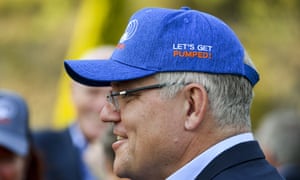Morrison government engages chief scientist to develop roadmap for potential $1.7bn export industry
The Morrison government will on Friday open public consultations on a
national hydrogen strategy, after engaging Australia’s chief scientist
to develop a roadmap with the cooperation of Canberra and the states.
The Coalition’s move, which is part of a broader climate and energy policy reboot executed this week, follows a commitment from Labor in January to set aside $1bn in funding from the Clean Energy Finance Corporation for clean hydrogen development, and to invest up to $90m from the Australian Renewable Energy Agency for research, demonstration and pre-commercial deployment of hydrogen technologies.
Labor is pointing to hydrogen as a clean fuel of the future, with the potential to gradually replace Australia’s export earnings from coal. But the federal resources minister Matt Canavan has declared the Coalition’s approach to developing the industry “won’t blindly turn our back on coal and the jobs it supports.”
Hydrogen is being promoted as a replacement for natural gas. It is being used overseas in the transport sector and in electricity generation.
Last December, the chief scientist Alan Finkel recommended state and federal energy ministers take three immediate steps to develop the industry. He recommended work to allow up to 10% hydrogen in the domestic gas network, including making the required regulatory changes and implementation of technical standards.
He said governments should scope potential for building hydrogen
refueling stations in every state and territory, focussed on heavy
transport, and undertake what he termed “co-ordinated international
outreach to keep building Australia’s profile with major trading
partners as a potential supplier”.
Finkel said heavy vehicles powered by hydrogen fuel cells
could meet increasing demand for zero-emissions transport, and replacing
natural gas with hydrogen was an economical way of decarbonising direct
combustion.The Coalition’s move, which is part of a broader climate and energy policy reboot executed this week, follows a commitment from Labor in January to set aside $1bn in funding from the Clean Energy Finance Corporation for clean hydrogen development, and to invest up to $90m from the Australian Renewable Energy Agency for research, demonstration and pre-commercial deployment of hydrogen technologies.
Labor is pointing to hydrogen as a clean fuel of the future, with the potential to gradually replace Australia’s export earnings from coal. But the federal resources minister Matt Canavan has declared the Coalition’s approach to developing the industry “won’t blindly turn our back on coal and the jobs it supports.”
Hydrogen is being promoted as a replacement for natural gas. It is being used overseas in the transport sector and in electricity generation.
Last December, the chief scientist Alan Finkel recommended state and federal energy ministers take three immediate steps to develop the industry. He recommended work to allow up to 10% hydrogen in the domestic gas network, including making the required regulatory changes and implementation of technical standards.
Finkel told ministers if Australia moved assertively into the hydrogen market, the country could build an export industry worth $1.7bn and provide employment for 2,800 people by 2030. He also noted that most of the jobs created would likely be in regional areas “at sites of hydrogen production, storage and loading for export”.
He identified Japan, South Korea and China as the likely main export markets, and noted “the window of opportunity to capture emerging markets in Asia is a small one”.
“Australia has competitive advantages, such as access to infrastructure and large renewable energy potential, but must act swiftly and in a coordinated way to ensure Australia’s place in the hydrogen value chain,” the chief scientist said.
The Coalition has already given a $50m grant to a coal-to-hydrogen project in the La Trobe Valley which is being spearheaded by a consortium of Japanese companies with the support of the Japanese government.
Environmental groups are positive in principle about the potential for Australia to develop a hydrogen export industry, but argue it should be powered by renewables rather than by gas or coal otherwise it will not assist a necessary transition to low emissions energy.
Moving ahead with a hydrogen strategy comes at the end of a week where Scott Morrison has attempted to reposition the government on climate and energy policy, with Liberals under attack in their heartland from independents campaigning against incumbents because of the government’s record of frustrating climate policy action.
Over the past week, Morrison has revived Tony Abbott’s emissions reduction fund, and pledged support for the Snowy 2.0 expansion, kicked in $56m for the Marinus link, and flagged further taxpayer underwriting of the “battery of the nation” proposal in Tasmania.
While the government is trying to send a more positive message about its disposition on emissions reduction, official figures have cut across the pre-election messaging, confirming pollution is continuing to rise, a trend that has been in evidence since the Coalition repealed Labor’s carbon price in 2013.
Emissions for the year to September 2018 went up 0.9% on the previous year, according to the latest inventory, primarily due to a 19.7% increase in LNG exports, but there were also increases in stationary energy, transport, fugitives, industrial processes and waste sectors.
While the government this week has outlined actions which is says are consistent with Australia meetings its Paris commitments, it has confirmed it intends to count a 367 megatonne abatement from carry-over credits, which is not practical emissions reduction but an accounting system that allows countries to count carbon credits from exceeding their targets under the soon-to-be-obsolete Kyoto protocol periods against their Paris commitment for 2030.It is also factoring in emissions reduction from the Snowy 2.0 expansion; energy efficiency measures; an electric vehicle strategy for which there are no details; the rebadged climate solutions fund; additional hydro projects and just under 100Mt of abatement from unspecified “technology solutions” and “other sources of abatement” such as projects under development but not yet contracted.

No comments:
Post a Comment